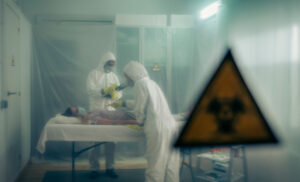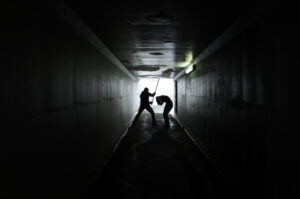Santa Maria’s first eruption in five hundred years exploded into action with a VEI of 6, the same size as that of Krakatau. The eruption devastated 120,000 square miles of surrounding territory and killed 5,000 people.
The first eruption of Santa Maria in recorded history occurred on October 24, 1902. Before 1902 it had been dormant for at least five hundred years. The eruption, with a VEI of 6, equivalent in magnitude to both Krakatau in Indonesia in 1883 and Katmai in Alaska in 1912, was the second biggest of the twentieth century. The eruption formed a large crater on the mountain’s southwest flank and blasted volcanic ash twenty miles into the atmosphere. The ash that subsequently fell devastated most of the 120,000 square miles of surrounding territory. Volcanic ash was detected as far away as San Francisco—a distance of 2,500 miles.
The crater on the southwest flank was half a mile in width and a thousand feet deep. It stretched from just below the summit down to the 7,000-foot level. Because of the lack of previous activity at Santa Maria, local people failed to recognize the warning signs that arrived in the days before October 24. At least 5,000 people were killed by the eruption. Many more died from a subsequent outbreak of malaria. The city of Quezaltenango sits below the 11,000-foot-high Santa Maria. It is the second most populous city of Guatemala and has a present population of 300,000. It is located in the Sierra Madre range of volcanoes that extend along the western part of Guatemala, separated from the Pacific Ocean by a broad plain.
These volcanoes are formed by the subduction of the Cocos Plate under the Caribbean Plate. Eruptions at Santa Maria are estimated to have begun about 30,000 years ago and continued intermittingly for many thousands of years right up to the quiescent period that preceded the event of 1902. This enormous blast of ash and pyroclastic material was followed by twenty years of dormancy. Then, in 1922, a new volcanic vent formed within the existing crater, forming a new volcano. It was named Santiaguito and it has been erupting ever since and now forms a cone a thousand feet tall, reaching a height of 7,000 feet. Thus, today it is possible to climb to the top of Santa Maria and look down on the ongoing eruptions at Santiaguito, 4,000 feet below. Dome growth at Santiaguito has alternated between growth caused by the emission of lava flows, and inflation caused by the injection of magma into the middle of the dome. Activity has been concentrated at several different vents, and Santiaguito now has the appearance of several overlapping domes. Although most of Santiaguito’s eruptive activity has been gentle, occasional larger explosions have occurred. In 1929, part of the dome collapsed, generating pyroclastic flows and killing several hundred people.
Occasional rock falls have generated smaller pyroclastic flows, and vertical eruptions of ash to heights of 2,000 feet above the dome are common. The areas to the south of Santa Maria are substantially affected by volcanic activity at Santiaguito. The most common damage comes from mudflows in the rainy season due to heavy rainfall on loose volcanic deposits. The town of El Palmar was twice destroyed by these mudflows and infrastructure such as roads and bridges have been repeatedly hit. One hazard, potentially devastating, is the possibility of the collapse of Santa Maria. The 1902 crater has left the southern flank of the mountain above Santiaguito very steep. A large earthquake or an eruption from Santiaguito could trigger a huge landslide.
In light of the threat it poses to nearby populations, Santa Maria has been designated a Decade Volcano, identifying it as a target for detailed study. Since volcanic eruptions can have additional local effects such as the disruption of air traffic by ash clouds, the unique perspective provided by views from a space shuttle or from the International Space Station (ISS) enable scientists to see not only the horizontal influence of the eruption within the atmosphere, but also the vertical effects. The ISS can plan passes over any give target two or more times daily, so that astronauts can photograph happenings many times and can coordinate with ground observers as well. Volcanic eruptions, another Dynamic Events target of Crew Earth Observations, produce aerosols that are distributed globally and influence atmospheric temperatures, cloud formation, and rainfall.























1 thought on “Santa Maria Volcanic Eruption – Guatemala – October 24, 1902”
good